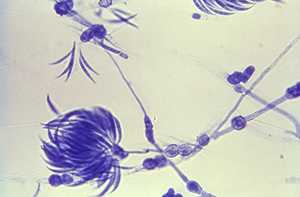Basics of Fungal Keratitis
What is fungal keratitis?

Microscopic image of Fusarium, a fungus that causes eye infections.
Fungal keratitis is an infection of the cornea (the clear dome covering the colored part of the eye) that is caused by a fungus. Some fungi that have been known to commonly cause fungal keratitis include 1:
- Fusarium species
- Aspergillus species
- Candida species
What are symptoms of fungal keratitis?
Symptoms of fungal keratitis include:
- Eye pain
- Eye redness
- Blurred vision
- Sensitivity to light
- Excessive tearing
- Eye discharge
If you experience any of these symptoms, remove your contact lenses (if you wear them) and call your eye doctor right away. Fungal keratitis is a very rare condition, but if left untreated, it can become serious and result in vision loss or blindness.
Where are these fungi found?
Fusarium and Aspergillus species live in the environment 2. Candida species normally live on human skin and on the protective lining inside the body called the mucous membrane. Fungal keratitis is most common in tropical and sub-tropical regions of the world, but can also occur in areas of the world with milder temperatures 3. It cannot be spread from person to person.
What puts people at risk for fungal keratitis?
The most common way that someone gets fungal keratitis is after experiencing trauma to the eye— especially trauma caused by a stick, thorn, or plant 1, 2.
Risks for developing fungal keratitis include 2:
- Recent eye trauma, particularly involving plants (for example, thorns or sticks)
- Underlying eye disease
- Weakened immune system
- Contact lens use
In 2006, CDC investigated an outbreak of Fusarium keratitis that was associated with a specific type of contact lens solution, which was withdrawn from the market 4-6.
How is fungal keratitis diagnosed?
Your eye doctor will examine your eye and may possibly take a tiny scraping of your cornea. The sample will be sent to a laboratory to be analyzed.
How is fungal keratitis treated?
Fungal keratitis must be treated with prescription antifungal medicine for several months. Patients who do not get better after skin treatment and oral antifungal medications may require surgery, including corneal transplantation 2.
How do you prevent fungal keratitis?
Protective eyewear is recommended for people who are at risk for eye trauma involving plants, such as agricultural workers.
Follow these tips to keep your eyes healthy while wearing contact lenses. Your daily habits, your contact lenses and supplies, and your eye doctor are all important.
For more information and additional resources, visit CDC’s Fungal Eye Infections website.
References
- Thomas PA, Kaliamurthy J. Mycotic keratitis: epidemiology, diagnosis and management. Clin Microbiol Infect. 2013;19:210-20.
- Bharathi MJ, Ramakrishnan R, Vasu S, Meenakshi R, Palaniappan R. Epidemiological characteristics and laboratory diagnosis of fungal keratitis. A three-year study. Indian J Ophthalmol. 2003;51:315-21.
- Srinivasan M. Fungal keratitis. Curr Opin Ophthalmol. 2004;15:321-7.
- CDC. Update: Fusarium keratitis--United States, 2005-2006. MMWR Morb Mortal Wkly Rep. 2006;55:563-4.
- CDC. Fusarium keratitis--multiple states, 2006. MMWR Morb Mortal Wkly Rep. 2006;55:400-1.
- Chang DC, Grant GB, O'Donnell K, Wannemuehler KA, Noble-Wang J, Rao CY, Jacobson LM, Crowell CS, Sneed RS, Lewis FM, Schaffzin JK, Kainer MA, Genese CA, Alfonso EC, Jones DB, Srinivasan A, Fridkin SK, Park BJ, Fusarium Keratitis Investigation Team. Multistate outbreak of Fusarium keratitis associated with use of a contact lens solution. JAMA. 2006; 296: 953-63.
- Page last reviewed: October 10, 2014
- Page last updated: January 27, 2015
- Content source:


 ShareCompartir
ShareCompartir